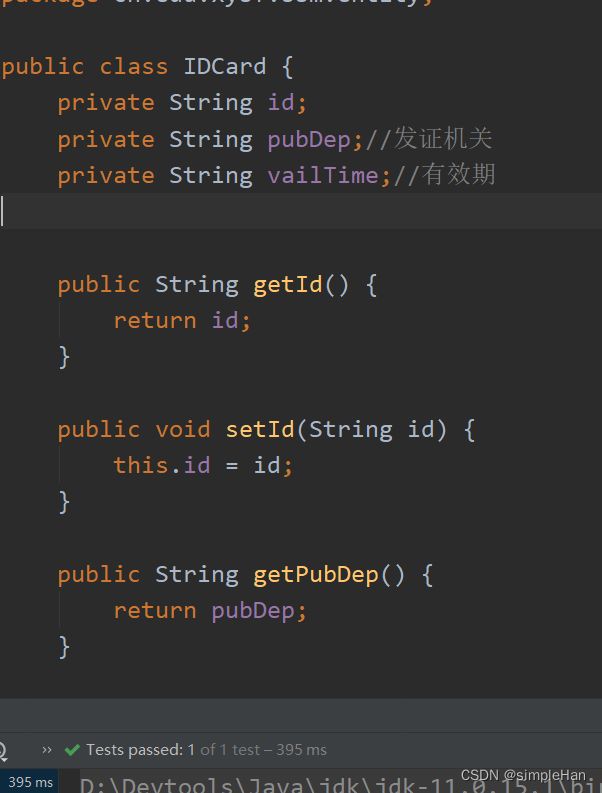Spring依赖注入和ioc在spring中的实现方式
目录
一、依赖注入
1.IOC思想
2.什么是依赖注入?
3.实例化对象中有pojo类型属性
二、IOC在Spring中的实现方式
1.获取bean的三种方式
1.1根据bean的id获取
1.2根据bean的类型获取(最常用,因为在IOC容器中,一个类型的bean只需要配置一次就够了)
1.3根据bean的id和类型进行获取
1.4根据类所实现的类的类型获取(通过接口获取)
一、依赖注入
1.IOC思想
IOC:Inversion Of Control 翻译:控制反转
举个例子:
自己做饭:买菜,洗菜,切菜,炒菜~~~~等等步骤和细节都需要自己清楚的知道
点外卖:下单,等,吃,不需要关心创建细节
controller----->Service------>dao
controller依赖于Service,Service依赖于dao
2.什么是依赖注入?
依赖注入即程序在运行时,希望给某个对象所依赖的对象赋值,就称为依赖注入(需要什么,传递什么,传递的任务由Spring完成)
简单来说就是对Controller所依赖的对象进行赋值,依赖哪个对象,spring就对哪个对象进行赋值。
注入(赋值)方式由三种:
- setter方法注入
- 构造方法注入
- 注解注入
示例1:setter注入,通过
基本数据类型的成员属性直接通过value赋值。
对应的bean:
测试类:
@Test
public void PersonTest(){
//1。需要实例化IOC容器,子类
ApplicationContext context = new ClassPathXmlApplicationContext("spring-config.xml");
//2.从IOC容器中拿到想要的对象
Person person = (Person)context.getBean("person");
System.out.println(person);
}运行结果:
示例2:构造器注入
假如实体类有五个属性,但是只给四个属性赋值,此时可以使用name,name可以为value指定它所赋值的属性
对应的bean:
@Test
public void testDI02(){
//获取IOC容器
ApplicationContext ioc = new ClassPathXmlApplicationContext("spring-ioc.xml");
//获取bean
Student studentThree = ioc.getBean("studentThree", Student.class);
System.out.println(studentThree);
}注入(赋值)的数据类型有三种:
- 基本数据类型和String类型
- 普通POJO类型(必须在Spring的配置文件中出现过的bean)
- 复杂类型(集合类型)
3.实例化对象中有pojo类型属性
如果Person类中有一个pojo类型的属性,假如是idCard,则在Person类中添加这个POJO属性,然后新建一个IdCard类
添加对应的bean
运行结果:
二、IOC在Spring中的实现方式
- BeanFactory实现:基本实现,spring内部使用的接口,面向spring本身,不对开发人员开放
- ApplicationContext实现:BeanFactory的子接口,功能更多,面向开发人员。
以上只是接口,没有具体的实现方法。
ClassPathXMLApplicationContext:类路径下的XML配置文件,推荐使用。
FileSystemXmlApplicationContext:文件系统路径下的XML配置文件,不推荐使用,因为之后的项目会在不同的电脑上运行,配置文件不一定存在于每个电脑上
目前为止spring配置文件的名字可以随便起,但是到了ssm整合时会有固定的名字。
配置文件的作用就是获取IOC容器,底层通过反射和工厂模式实现
1.获取bean的三种方式
1.1根据bean的id获取
根据bean的id获取时,实例化对象中一定要有无参构造方法,否则会报错(NoSuchMethodException)。
@Test
public void testIOC(){
//获取IOC容器
ApplicationContext ioc = new ClassPathXmlApplicationContext("spring-ioc.xml");
//根据id获取bean对象
Student studentOne = (Student) ioc.getBean("studentOne");
System.out.println(student);
}1.2根据bean的类型获取(最常用,因为在IOC容器中,一个类型的bean只需要配置一次就够了)
通过类型获取到的对象,返回值就是该类型的实例化对象,
注意:根据类型获取bean时,要求IOC容器中有且只有一个bean,否则会报错(NoUniqueBeanDefinitionException)。
@Test
public void testIOC(){
//获取IOC容器
ApplicationContext ioc = new ClassPathXmlApplicationContext("spring-ioc.xml");
//根据类型获取
Student student = ioc.getBean(Student.class);
System.out.println(student);
}1.3根据bean的id和类型进行获取
@Test
public void testIOC(){
//获取IOC容器
ApplicationContext ioc = new ClassPathXmlApplicationContext("spring-ioc.xml");
//根据bean的id和类型进行获取
Student studentOne = ioc.getBean("studentOne", Student.class);
System.out.println(studentOne);
}1.4根据类所实现的类的类型获取(通过接口获取)
@Test
public void testIOC(){
//获取IOC容器
ApplicationContext ioc = new ClassPathXmlApplicationContext("spring-ioc.xml");
//根据接口实获取
Person person = ioc.getBean(Person.class);
System.out.println(person);
}
结论:根据类型来获取bean时,在满足bean唯一性的前提下
其实只是看:【对象 instanceof 指定的类型 】的返回值
只要返回的时true既可以认定和类型匹配,能够获取到
即通过bean的类型、bean所继承的类的类型,bean所实现的类的类型都可以获取到bean







